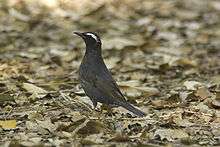Siberian thrush
| Siberian thrush | |
|---|---|
 | |
| Scientific classification | |
| Kingdom: | Animalia |
| Phylum: | Chordata |
| Class: | Aves |
| Order: | Passeriformes |
| Family: | Turdidae |
| Genus: | Geokichla |
| Species: | G. sibirica |
| Binomial name | |
| Geokichla sibirica (Pallas, 1776) | |
| Synonyms | |
|
Zoothera sibirica | |
The Siberian thrush (Geokichla sibirica) is a member of the thrush family, Turdidae.
It breeds in taiga in Siberia. It is strongly migratory, with most birds moving to southeastern Asia during the winter. It is a very rare vagrant to western Europe. It is very secretive.
The Siberian thrush is similar in size to the song thrush. It is omnivorous, eating a wide range of insects, earthworms and berries.
The male Siberian thrush is a dark blue-grey above and below, with a white stripe above the eye. The lower belly and flanks are white. The female is a much browner bird, with a buff stripe above the eye.
A striking identification feature of both sexes in flight is the black band on the white underwings, a feature shared with the scaly thrush.
References
- ↑ BirdLife International (2012). "Zoothera sibirica". IUCN Red List of Threatened Species. Version 2013.2. International Union for Conservation of Nature. Retrieved 26 November 2013.
